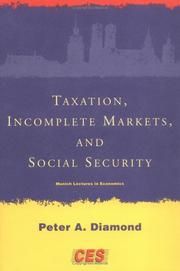| Listing 1 - 10 of 10 |
Sort by
|

ISBN: 0226756262 9786611430535 1281430536 0226756289 9780226756288 9780226756264 Year: 1997 Publisher: Chicago University of Chicago Press
Abstract | Keywords | Export | Availability | Bookmark
 Loading...
Loading...Choose an application
- Reference Manager
- EndNote
- RefWorks (Direct export to RefWorks)
Restrictions on foreign investment in U.S. telecommunications firms have harmed the interests of American consumers and investors, argues J. Gregory Sidak in this convincing study. Sidak shows why these restrictions, originally intended to protect America from the perils of wireless telegraphy by foreign agents, should be repealed. Basing his analysis on legislative history, statutory and constitutional interpretation, and finance and trade theory, Sidak shows that these restrictions no longer serve their national security purpose (if they ever did). Instead they deny American consumers lower prices and more robust innovation, hamper access of American investors to foreign telecommunications markets, and unconstitutionally impinge on freedom of speech. Sidak's study encompasses the Telecommunications Act of 1996, recent global mergers such as British Telecom-MCI, and the 1997 World Trade Organization agreement to liberalize trade in telecommunications services.
Telecommunication --- Investments, Foreign --- Law and legislation --- E-books --- foreign investment, telecommunications, business, legislation, regulation, government, capitalism, wireless telegraphy, national security, finance, ownership, control, policy, free speech, wto, nonfiction, consumers, prices, innovation, british telecom-mci, economics, world trade organization, constitution, law, legal, politics, corporate, commerce.
Book
ISBN: 1281223425 9786611223427 0226260240 Year: 1993 Publisher: Chicago : University of Chicago Press,
Abstract | Keywords | Export | Availability | Bookmark
 Loading...
Loading...Choose an application
- Reference Manager
- EndNote
- RefWorks (Direct export to RefWorks)
As Japan's newfound economic power leads to increased political power, there is concern that Japan may be turning East Asia into a regional economic bloc to rival the U.S. and Europe. In Regionalism and Rivalry, leading economists and political scientists address this concern by looking at three central questions: Is Japan forming a trading bloc in Pacific Asia? Does Japan use foreign direct investment in Southeast Asia to achieve national goals? Does Japan possess the leadership qualities necessary for a nation assuming greater political responsibility in international affairs? The authors contend that although intraregional trade in East Asia is growing rapidly, a trade bloc is not necessarily forming. They show that the trade increase can be explained entirely by factors independent of discriminatory trading arrangements, such as the rapid growth of East Asian economies. Other chapters look in detail at cases of Japanese direct investment in Southeast Asia and find little evidence of attempts by Japan to use the power of its multinational corporations for political purposes. A third group of papers attempt to gauge Japan's leadership characteristics. They focus on Japan's "technology ideology," its contributions to international public goods, international monetary cooperation, and economic liberalization in East Asia.
Investments, Japanese --- East Asia --- Japan --- Southeast Asia --- United States --- Economic integration --- Foreign economic relations --- japan, economics, power, government, foreign relations, political science, regionalism, trading bloc, pacific asia, investment, leadership, economy, growth, pricing strategies, yen, technology, industry, aircraft, military, manufacturing, national security, finance, regional cooperation, domestic politics, economic liberalization, burdensharing, aid, nonfiction, trade.

ISBN: 1280070129 0203217152 0415282780 0203294173 0429229836 1134457774 9780203217153 9781134457762 1134457766 9781134457779 9781134457724 9780415282789 Year: 2002 Publisher: London Routledge
Abstract | Keywords | Export | Availability | Bookmark
 Loading...
Loading...Choose an application
- Reference Manager
- EndNote
- RefWorks (Direct export to RefWorks)
Increasingly ageing populations and a slowing rate of growth in the macroeconomy are forcing advanced countries to reconsider their social security programmes. The need for detailed examination of the possible reforms and initiatives has never been greater.This book brings together internationally-renowned scholars to evaluate the effect of recent social security reforms in advanced countries (pension programmes in particular) and to suggest policy reforms for the future.Including detailed studies of countries including Australia, Germany, Japan, Scandinavia, the UK and the USA, this b
Pension trusts. --- Privatization. --- Social action. --- Social security. --- Social security - Finance - Congresses. --- Social security --- Privatization --- Pension trusts --- Finance --- AA / International- internationaal --- DE / Germany - Duitsland - Allemagne --- GB / United Kingdom - Verenigd Koninkrijk - Royaume Uni --- JP / Japan - Japon --- US / United States of America - USA - Verenigde Staten - Etats Unis --- 368.43 --- 332.832 --- Ouderdomsverzekering. Voorbarige dood. Weduwen en wezen. --- Pensioen. Brugpensioen. --- Employee pension trusts --- Pension funds --- Pension plans --- Insurance, Social --- Insurance, State and compulsory --- Social insurance --- Trusts and trustees --- Insurance --- Income maintenance programs --- Pensioen. Brugpensioen --- Ouderdomsverzekering. Voorbarige dood. Weduwen en wezen
Book
ISBN: 1616359501 130656865X 1475565321 1484395093 1475565194 9781475565195 9781616359508 9781484395097 9781475565324 Year: 2014 Publisher: Washington, D.C. : International Monetary Fund,
Abstract | Keywords | Export | Availability | Bookmark
 Loading...
Loading...Choose an application
- Reference Manager
- EndNote
- RefWorks (Direct export to RefWorks)
Pension reform is high on the agenda of many advanced and emerging market economies, for many reasons. First, public pensions often constitute a large share of government expenditure. Second, population aging means that reforms would be needed just to keep pension spending from rising in the future. Third, in many economies, low or falling pension coverage will leave large segments of the population without adequate income in old age and at risk of falling into poverty. Although a number of studies have assessed the effects of pension reforms on fiscal sustainability, a systematic analysis of equity issues in pension systems—and how countries have grappled with these issues—has yet to be undertaken. This book brings together the latest research on equity issues related to pension systems and pension reforms in the post-crisis world. Some of the key issues covered include: the effect of pension systems on intergenerational equity and the impact of pension reforms on poverty, the effects of pension reform measures on fiscal sustainability and equity, and the fiscal consequences of achieving different equity goals. It also presents country case studies. The volume provides a rich menu of material to assist policymakers and academic audiences seeking to understand the latest research in this area, as well as the lessons and challenges for the design of reforms.
Insurance. --- Pensions. --- Retirement income. --- Social security -- Finance. --- Pensions --- Retirement income --- Business & Economics --- Labor & Workers' Economics --- Compensation --- Pension plans --- Retirement pensions --- Superannuation --- Income --- Annuities --- Social security individual investment accounts --- Vested benefits --- E-books --- #SBIB:316.8H40 --- #SBIB:35H437 --- Sociaal beleid: social policy, sociale zekerheid, verzorgingsstaat --- Beleidssectoren: sociale zekerheid --- Singapore --- Labor --- Macroeconomics --- Public Finance --- Demography --- Poverty and Homelessness --- Social Security and Public Pensions --- Nonwage Labor Costs and Benefits --- Private Pensions --- Economics of the Elderly --- Economics of the Handicapped --- Non-labor Market Discrimination --- Retirement --- Retirement Policies --- Aggregate Factor Income Distribution --- Population & demography --- Labour --- income economics --- Public finance & taxation --- Pension spending --- Aging --- Pension reform --- Expenditure --- Population and demographics --- Population aging --- Wages --- Poverty --- Income economics

ISBN: 9780226310176 0226310175 9786612004889 1282004883 0226310000 9780226310008 Year: 2007 Publisher: Chicago University of Chicago
Abstract | Keywords | Export | Availability | Bookmark
 Loading...
Loading...Choose an application
- Reference Manager
- EndNote
- RefWorks (Direct export to RefWorks)
The future of Social Security is troubled, both in the United States and in most other developed countries with aging populations. As improvements in health care and changes in life styles enable retirees to live longer than ever before, the stress on national budgets will increase substantially. In Social Security Programs and Retirement around the World, Jonathan Gruber, David A. Wise, and experts in many countries examine the consequences of reforming retirement benefits in a dozen nations. Drawing on the work of an international group of noted economists, the editors argue that social security programs provide strong incentives for workers to leave the labor force by retiring and taking the benefits to which they are entitled. By penalizing work, social security systems magnify the increased financial burden caused by aging populations, thus contributing to the insolvency of the system. This book is a model of comparative analysis that evaluates the effects of illustrative policies for countries facing the impending rapid growth of social security benefits. Its insights will help inform one of the most pressing debates.
Social Security --- Retirement --- Retirement income --- Older people --- finance --- Economic aspects --- Employment --- AA / International- internationaal --- 368.43 --- 332.832 --- 368.40 --- 336.204 --- Ouderdomsverzekering. Voorbarige dood. Weduwen en wezen. --- Pensioen. Brugpensioen. --- Sociale voorzorg en verzekeringen. Sociale zekerheid: algemeenheden. --- weerslag, invloed, last en verdeling van de belasting. --- Older people. --- Older people - Employment. --- Retirement. --- Retirement - Economic aspects. --- Retirement income. --- Social security - Finance. --- Social security. --- Social security --- Developed Countries --- Socioeconomic Factors --- Aged --- Public Assistance --- International Cooperation --- Adult --- Insurance --- Population Characteristics --- Sociology --- Human Activities --- Financing, Organized --- Age Groups --- Social Sciences --- Anthropology, Education, Sociology and Social Phenomena --- Financing, Government --- Internationality --- Health Care --- Persons --- Economics --- Health Care Economics and Organizations --- Named Groups --- Labor & Workers' Economics --- Business & Economics --- Finance --- Finance. --- Economic aspects. --- Employment. --- Superannuation --- Termination of employment --- Leisure --- Old age --- Income --- Older unemployed --- Pensioen. Brugpensioen --- weerslag, invloed, last en verdeling van de belasting --- Sociale voorzorg en verzekeringen. Sociale zekerheid: algemeenheden --- Ouderdomsverzekering. Voorbarige dood. Weduwen en wezen --- Social Security - finance --- Retirement - Economic aspects --- Older people - Employment --- social security, retirement, pension, government, reform, saving, aging, international, wealth, poverty, labor, employment, economics, politics, political science, economy, healthcare, national budgets, benefits, insolvency, finance, belgium, canada, denmark, income, france, germany, italy, japan, netherlands, spain, sweden, expenditure, nonfiction.

ISBN: 0198283369 0191521310 1282268031 9786612268038 9780198283362 9780191521317 9780191595875 019159587X Year: 1995 Publisher: Oxford Clarendon
Abstract | Keywords | Export | Availability | Bookmark
 Loading...
Loading...Choose an application
- Reference Manager
- EndNote
- RefWorks (Direct export to RefWorks)
This book surveys the current state of public economics by taking as a case study the proposal for a basic income financed by a flat income tax. It revises the area in which there has been active research in recent years, including the theory of optimum, the incidence of taxation, public choice theory, and tax benefit models.
Flat-rate income tax --- Guaranteed annual income --- Income tax --- Social choice --- Social security --- Impôt sur le revenu --- Revenu annuel garanti --- Choix collectif --- Sécurité sociale --- Finance --- Taux uniforme --- Finances --- Social Security --- finance --- 336.1 --- 336.215.21 --- 36 --- 330.56 --- -Guaranteed annual income --- 351.713*12 --- Choice, Social --- Collective choice --- Public choice --- Choice (Psychology) --- Social psychology --- Welfare economics --- Annual income guarantee --- Guaranteed income --- Economic security --- Income --- Income maintenance programs --- Insurance, Social --- Insurance, State and compulsory --- Social insurance --- Insurance --- Flat income tax --- Flat-rate tax --- Flat tax --- Tax, Flat --- Personal income tax --- Taxable income --- Taxation of income --- Direct taxation --- Internal revenue --- Progressive taxation --- Tithes --- Wages --- Public finance, government finance in general --- Negatieve belastingsinkomsten --- Maatschappelijk werk --- Nationaal inkomen. Volksinkomen. Gezinsinkomen. Vermogensstratificatie. Particuliere inkomens en bestedingen. Armoede. Honger --- Taxation --- Flat-rate income tax. --- Guaranteed annual income. --- Income tax. --- Social choice. --- Finance. --- 330.56 Nationaal inkomen. Volksinkomen. Gezinsinkomen. Vermogensstratificatie. Particuliere inkomens en bestedingen. Armoede. Honger --- 36 Maatschappelijk werk --- 336.215.21 Negatieve belastingsinkomsten --- 336.1 Public finance, government finance in general --- Impôt sur le revenu --- Sécurité sociale --- E-books --- Basic income. --- Basic income guarantee --- Guaranteed minimum income --- Universal basic income --- Basic income --- 36 Safeguarding the mental and material necessities of life --- Safeguarding the mental and material necessities of life --- 36 Waarborgen van de mentale en materiële behoeften van het leven; maatschappelijk werk --- Waarborgen van de mentale en materiële behoeften van het leven; maatschappelijk werk --- Social Security - finance

ISBN: 0262042134 0262271680 1423729595 9780262271684 9780262042130 9781423729594 Year: 2003 Publisher: Cambridge, Mass. MIT Press
Abstract | Keywords | Export | Availability | Bookmark
 Loading...
Loading...Choose an application
- Reference Manager
- EndNote
- RefWorks (Direct export to RefWorks)
In this book, Peter Diamond analyzes social security as a particular example of optimal taxation theory. Assuming a world of incomplete markets and asymmetric information, he uses a variety of simple models to illuminate the economic forces that bear on specific social security policy issues. The focus is on the degree of progressivity desirable in social security and the design of incentives to delay retirement beyond the earliest age of eligibility for benefits. Before analyzing these models, Diamond presents introductions to optimal income tax theory and the theory of incomplete markets. He incorporates recent theoretical developments such as time-inconsistent preferences into his analyses and shows that distorting taxes and a measure of progressivity in benefits are desirable. Diamond also discusses social security reform, with a focus on Germany.
Welfare economics --- Welfare state --- Taxation --- Capitalism --- Social Security --- Social security --- finance --- Finance --- 36 --- 336.2 --- -Social security --- -Taxation --- -Welfare economics --- AA / International- internationaal --- DE / Germany - Duitsland - Allemagne --- 336.200 --- 336.024 --- 368.40 --- State, Welfare --- Economic policy --- Public welfare --- Social policy --- State, The --- Economics --- Duties --- Fee system (Taxation) --- Tax policy --- Tax reform --- Taxation, Incidence of --- Taxes --- Finance, Public --- Revenue --- Insurance, Social --- Insurance, State and compulsory --- Social insurance --- Insurance --- Income maintenance programs --- Market economy --- Profit --- Capital --- Maatschappelijk werk --- Belastingsakkoorden. Belastingswezen --- Belastingstelsel: algemene naslagwerken en principes. --- Sociale begroting, rekeningen en uitgaven. Gezondheid. --- Sociale voorzorg en verzekeringen. Sociale zekerheid: algemeenheden. --- Capitalism. --- Taxation. --- Welfare economics. --- Welfare state. --- Finance. --- 336.2 Belastingen. Belastingswezen. Openbare financien. Belastingspolitiek. Belastingstheorie. Belastingsharmonisatie. Fiskale politiek. Belastingsleer. Belastingsdruk. Belastingstechniek. Belastingsstelsel.Belastingstarief --- 336.2 Belastingsakkoorden. Belastingswezen --- Belastingen. Belastingswezen. Openbare financien. Belastingspolitiek. Belastingstheorie. Belastingsharmonisatie. Fiskale politiek. Belastingsleer. Belastingsdruk. Belastingstechniek. Belastingsstelsel.Belastingstarief --- 36 Maatschappelijk werk --- Sociale begroting, rekeningen en uitgaven. Gezondheid --- Belastingstelsel: algemene naslagwerken en principes --- Sociale voorzorg en verzekeringen. Sociale zekerheid: algemeenheden --- ECONOMICS/Finance --- ECONOMICS/Macroeconomics --- ECONOMICS/Political Economy --- 36 Safeguarding the mental and material necessities of life --- Safeguarding the mental and material necessities of life --- 36 Waarborgen van de mentale en materiële behoeften van het leven; maatschappelijk werk --- Waarborgen van de mentale en materiële behoeften van het leven; maatschappelijk werk --- Social Security - finance --- Taxation - Germany --- Capitalism - Germany --- Social security - Germany - Finance
Book
ISBN: 1400888573 Year: 2018 Publisher: Princeton : Princeton University Press,
Abstract | Keywords | Export | Availability | Bookmark
 Loading...
Loading...Choose an application
- Reference Manager
- EndNote
- RefWorks (Direct export to RefWorks)
A powerful new understanding of global currency trends, including the rise of the Chinese yuanAt first glance, the modern history of the global economic system seems to support the long-held view that the leading world power's currency-the British pound, the U.S. dollar, and perhaps someday the Chinese yuan-invariably dominates international trade and finance. In How Global Currencies Work, three noted economists provide a reassessment of this history and the theories behind the conventional wisdom.Offering a new history of global finance over the past two centuries, and marshaling extensive new data to test established theories of how global currencies work, Barry Eichengreen, Arnaud Mehl, and Livia Chiţu argue for a new view, in which several national monies can share international currency status, and their importance can change rapidly. They demonstrate how changes in technology and in the structure of international trade and finance have reshaped the landscape of international currencies so that several international financial standards can coexist. They show that multiple international and reserve currencies have in fact coexisted in the pastupending the traditional view of the British pound's dominance prior to 1945 and the U.S. dollar's dominance more recently.Looking forward, the book tackles the implications of this new framework for major questions facing the future of the international monetary system, from whether the euro and the Chinese yuan might address their respective challenges and perhaps rival the dollar, to how increased currency competition might affect global financial stability.
Valute. --- Money. --- International finance. --- Account (accountancy). --- Annual report. --- Asset. --- Balance sheet. --- Bank for International Settlements. --- Bank of England. --- Bank of Japan. --- Bank rate. --- Bank. --- Barry Eichengreen. --- Bond (finance). --- Bretton Woods system. --- Canadian dollar. --- Capital control. --- Capital market. --- Central bank. --- Commodity. --- Credibility. --- Credit (finance). --- Credit risk. --- Currency Internationalization. --- Currency competition. --- Currency swap. --- Currency. --- Current account. --- Customer. --- Debt. --- Deflation. --- Determinant. --- Deutsche Mark. --- Devaluation. --- Discounts and allowances. --- Economics. --- Economist. --- Economy. --- Endogeneity (econometrics). --- Estimation. --- European Central Bank. --- Exchange rate. --- Export. --- Federal Reserve Bank. --- Fiat money. --- Finance. --- Financial crisis. --- Financial deepening. --- Financial institution. --- Financial transaction. --- Foreign Exchange Reserves. --- Foreign direct investment. --- Foreign exchange market. --- French franc. --- Gold reserve. --- Gold standard. --- Government debt. --- Gross world product. --- Import. --- Inflation. --- Institution. --- Interest rate. --- International Monetary Fund. --- International monetary systems. --- International trade. --- Internationalization. --- Investment. --- Investor. --- Invoice. --- Issuer. --- Liberalization. --- Local currency. --- Market capitalization. --- Market liquidity. --- Market participant. --- Monetary policy. --- Money market. --- Natural monopoly. --- Network effect. --- Payment. --- Pound sterling. --- Receipt. --- Renminbi. --- Reserve currency. --- Securitization. --- Security (finance). --- Sterling area. --- Store of value. --- Supply (economics). --- Swiss franc. --- Tax. --- Trade credit. --- Treasury Bill. --- U.S. Bancorp. --- Underwriting. --- Unit of account. --- United States dollar. --- Valuation effects. --- World War II. --- World currency. --- World economy.
Book
ISBN: 9780691150789 0691150788 9786613012081 1400838096 1283012081 Year: 2011 Publisher: Princeton Princeton university
Abstract | Keywords | Export | Availability | Bookmark
 Loading...
Loading...Choose an application
- Reference Manager
- EndNote
- RefWorks (Direct export to RefWorks)
The financial collapse of Fannie Mae and Freddie Mac in 2008 led to one of the most sweeping government interventions in private financial markets in history. The bailout has already cost American taxpayers close to $150 billion, and substantially more will be needed. The U.S. economy--and by extension, the global financial system--has a lot riding on Fannie and Freddie. They cannot fail, yet that is precisely what these mortgage giants are guaranteed to do. How can we limit the damage to our economy, and avoid making the same mistakes in the future? Guaranteed to Fail explains how poorly designed government guarantees for Fannie Mae and Freddie Mac led to the debacle of mortgage finance in the United States, weighs different reform proposals, and provides sensible, practical recommendations. Despite repeated calls for tougher action, Washington has expanded the scope of its guarantees to Fannie and Freddie, fueling more and more housing and mortgages all across the economy--and putting all of us at risk. This book unravels the dizzyingly immense, highly interconnected businesses of Fannie and Freddie. It proposes a unique model of reform that emphasizes public-private partnership, one that can serve as a blueprint for better organizing and managing government-sponsored enterprises like Fannie Mae and Freddie Mac. In doing so, Guaranteed to Fail strikes a cautionary note about excessive government intervention in markets.
Business failures --- Financial crises --- Housing --- Mortgage loans --- History --- Finance. --- Government policy --- Freddie Mac (Firm). --- Federal National Mortgage Association. --- 333.109 --- 333.139.2 --- 333.17 --- 333.663 --- 333.733 --- 333.78 --- US / United States of America - USA - Verenigde Staten - Etats Unis --- Crashes, Financial --- Crises, Financial --- Financial crashes --- Financial panics --- Panics (Finance) --- Stock exchange crashes --- Stock market panics --- Crises --- Business mortality --- Failure in business --- Mortality, Business --- Success in business --- Finance --- Veiligheid. Bankovervallen. Bankrisico's --- Bankcontrole en -reglementering. Reglementering van het bankberoep --- Crises, saneringen en hervormingen van het bankwezen --- rating van bedrijven --- Krediet op grond en onroerende goederen --- Kredietcontrole. Credit crunch --- Freddie Mac (Firm) --- FNMA --- United States. --- F.N.M.A. --- FannieMae --- Fannie Mae --- Federal Home Loan Mortgage Corporation --- Affordable housing. --- Agency debt. --- Alt-A. --- Asset management. --- Asset. --- Balance sheet. --- Bank of America. --- Bank run. --- Bank. --- Bear Stearns. --- Ben Bernanke. --- Capital market. --- Capital requirement. --- Cash. --- Central bank. --- Citigroup. --- Commercial bank. --- Conservatorship. --- Countrywide. --- Credit (finance). --- Credit risk. --- Credit score in the United States. --- Credit score. --- Creditor. --- Debt. --- Dodd–Frank Wall Street Reform and Consumer Protection Act. --- Down payment. --- Economics. --- Economist. --- Economy. --- Equity (finance). --- Fannie Mae. --- Federal Housing Administration. --- Federal Housing Finance Agency. --- Financial crisis. --- Financial institution. --- Financial services. --- Fixed-rate mortgage. --- Foreclosure. --- Freddie Mac. --- Funding. --- Government National Mortgage Association. --- Government debt. --- Guarantee. --- Hedge fund. --- Heitor Almeida. --- Henry Paulson. --- Home equity. --- Household. --- Income. --- Insolvency. --- Insurance. --- Interest rate risk. --- Interest rate. --- Investment. --- Investor. --- JPMorgan Chase. --- Lehman Brothers. --- Lender of last resort. --- Leverage (finance). --- Line of credit. --- Macroeconomics. --- Market discipline. --- Market liquidity. --- Monetary policy. --- Moral hazard. --- Mortgage Rate. --- Mortgage bank. --- Mortgage loan. --- Payment. --- Pension fund. --- Percentage. --- Private mortgage. --- Private sector. --- Privatization. --- Quantitative easing. --- Race to the bottom. --- Real estate appraisal. --- Real estate economics. --- Receivership. --- Recession. --- Refinancing. --- Repurchase agreement. --- Resolution Trust Corporation. --- Return on equity. --- Saving. --- Savings and loan association. --- Secondary mortgage market. --- Securitization. --- Security (finance). --- Subprime. --- Subsidy. --- Systemic risk. --- Too big to fail. --- Underwriting Standards. --- Underwriting. --- Value (economics). --- Washington Mutual. --- Working paper.
Book
ISBN: 9780691223216 0691223211 Year: 2022 Publisher: Princeton, NJ
Abstract | Keywords | Export | Availability | Bookmark
 Loading...
Loading...Choose an application
- Reference Manager
- EndNote
- RefWorks (Direct export to RefWorks)
How the financial pressures of paying for college affect the lives and well-being of middle-class families The struggle to pay for college is a defining feature of middle-class life in America. Caitlin Zaloom takes readers into homes of families throughout the nation to reveal the hidden consequences of student debt and the ways that financing college has transformed our most sacred relationships. She describes the profound moral conflicts for parents as they try to honor what they see as their highest parental duty-providing their children with opportunity-and shows how parents and students alike are forced to gamble on an investment that might not pay off. Superbly written and unflinchingly honest, Indebted breaks through the culture of silence surrounding the student debt crisis, exposing the unspoken costs of sending our kids to college.
Student loans. --- Middle class families. --- Loans, Personal. --- Education, Higher --- SOCIAL SCIENCE / Social Classes --- Middle class families --- Loans, Personal --- Student loans --- Student loan funds --- Student loan programs --- Loans --- Student aid --- Scholarships --- Families --- Consumer loans --- Loans, Consumer --- Loans, Small --- Personal loans --- Small loans --- Consumer credit --- Finance. --- Costs. --- United States. --- 529 plan. --- Ability To Pay. --- Adviser. --- African American Family. --- African Americans. --- Aid. --- American middle class. --- Americans. --- Anthropologist. --- Associate degree. --- Bachelor's degree. --- Bankruptcy. --- Calculation. --- Capitalism. --- Career. --- Center for Advanced Study in the Behavioral Sciences. --- Center on Budget and Policy Priorities. --- College Board. --- Community college. --- Consideration. --- Customer. --- Debt. --- Determination. --- Economics. --- Economist. --- Education. --- Employment. --- Expected Family Contribution. --- Expense. --- FAFSA. --- Family Lives. --- Family income. --- Financial adviser. --- Financial literacy. --- For-profit higher education in the United States. --- Funding. --- Graduation. --- Grandparent. --- Higher education. --- His Family. --- Historically black colleges and universities. --- Home equity. --- Household. --- Income. --- Institution. --- Interview. --- Investment fund. --- Investor. --- Middle class. --- Mortgage loan. --- Nancy Fraser. --- Narrative. --- New York University. --- Nuclear family. --- Of Education. --- Oppression. --- PLUS Loan. --- Parenting. --- Payment. --- Pension. --- Poverty. --- Private school. --- Private university. --- Public institution (United States). --- Public university. --- Pundit. --- Racism. --- Rational choice theory. --- Remarriage. --- Repayment plan. --- Requirement. --- Research assistant. --- Retirement. --- Russell Sage Foundation. --- Salary. --- Sallie Mae. --- Saving. --- Scholarship. --- Security (finance). --- Sibling. --- Social mobility. --- Social science. --- Sociology. --- Standard of living. --- State school. --- Student debt. --- Student loan. --- Student. --- Subsidy. --- Tax. --- Technology. --- Trade-off. --- Tuition payments. --- Uncertainty. --- University. --- Vocational education. --- Wealth. --- Welfare. --- Year. --- ABŞ --- ABSh --- Ameerika Ühendriigid --- America (Republic) --- Amerika Birlăshmish Shtatlary --- Amerika Birlăşmi Ştatları --- Amerika Birlăşmiş Ştatları --- Amerika ka Kelenyalen Jamanaw --- Amerika Qūrama Shtattary --- Amerika Qŭshma Shtatlari --- Amerika Qushma Shtattary --- Amerika (Republic) --- Amerikai Egyesült Államok --- Amerikanʹ Veĭtʹsėndi͡avks Shtattnė --- Amerikări Pĕrleshu̇llĕ Shtatsem --- Amerikas Forenede Stater --- Amerikayi Miatsʻyal Nahangner --- Ameriketako Estatu Batuak --- Amirika Carékat --- AQSh --- Ar. ha-B. --- Arhab --- Artsot ha-Berit --- Artzois Ha'bris --- Bí-kok --- Ē.P.A. --- É.-U. --- EE.UU. --- Egyesült Államok --- ĒPA --- Estados Unidos --- Estados Unidos da América do Norte --- Estados Unidos de América --- Estaos Xuníos --- Estaos Xuníos d'América --- Estatos Unitos --- Estatos Unitos d'America --- Estats Units d'Amèrica --- Ètats-Unis d'Amèrica --- États-Unis d'Amérique --- ÉU --- Fareyniḳṭe Shṭaṭn --- Feriene Steaten --- Feriene Steaten fan Amearika --- Forente stater --- FS --- Hēnomenai Politeiai Amerikēs --- Hēnōmenes Politeies tēs Amerikēs --- Hiwsisayin Amerikayi Miatsʻeal Tērutʻiwnkʻ --- Istadus Unidus --- Jungtinės Amerikos valstybės --- Mei guo --- Mei-kuo --- Meiguo --- Mî-koet --- Miatsʻyal Nahangner --- Miguk --- Na Stàitean Aonaichte --- NSA --- S.U.A. --- SAD --- Saharat ʻAmērikā --- SASht --- Severo-Amerikanskie Shtaty --- Severo-Amerikanskie Soedinennye Shtaty --- Si͡evero-Amerikanskīe Soedinennye Shtaty --- Sjedinjene Američke Države --- Soedinennye Shtaty Ameriki --- Soedinennye Shtaty Severnoĭ Ameriki --- Soedinennye Shtaty Si͡evernoĭ Ameriki --- Spojené obce severoamerické --- Spojené staty americké --- SShA --- Stadoù-Unanet Amerika --- Stáit Aontaithe Mheiriceá --- Stany Zjednoczone --- Stati Uniti --- Stati Uniti d'America --- Stâts Unîts --- Stâts Unîts di Americhe --- Steatyn Unnaneysit --- Steatyn Unnaneysit America --- SUA --- Sŭedineni amerikanski shtati --- Sŭedinenite shtati --- Tetã peteĩ reko Amérikagua --- U.S. --- U.S.A. --- United States of America --- Unol Daleithiau --- Unol Daleithiau America --- Unuiĝintaj Ŝtatoj de Ameriko --- US --- USA --- Usono --- Vaeinigte Staatn --- Vaeinigte Staatn vo Amerika --- Vereinigte Staaten --- Vereinigte Staaten von Amerika --- Verenigde State van Amerika --- Verenigde Staten --- VS --- VSA --- Wááshindoon Bikéyah Ałhidadiidzooígíí --- Wilāyāt al-Muttaḥidah --- Wilāyāt al-Muttaḥidah al-Amirīkīyah --- Wilāyāt al-Muttaḥidah al-Amrīkīyah --- Yhdysvallat --- Yunaeted Stet --- Yunaeted Stet blong Amerika --- ZDA --- Združene države Amerike --- Zʹi͡ednani Derz͡havy Ameryky --- Zjadnośone staty Ameriki --- Zluchanyi͡a Shtaty Ameryki --- Zlucheni Derz͡havy --- ZSA
| Listing 1 - 10 of 10 |
Sort by
|

 Search
Search Feedback
Feedback About UniCat
About UniCat  Help
Help News
News